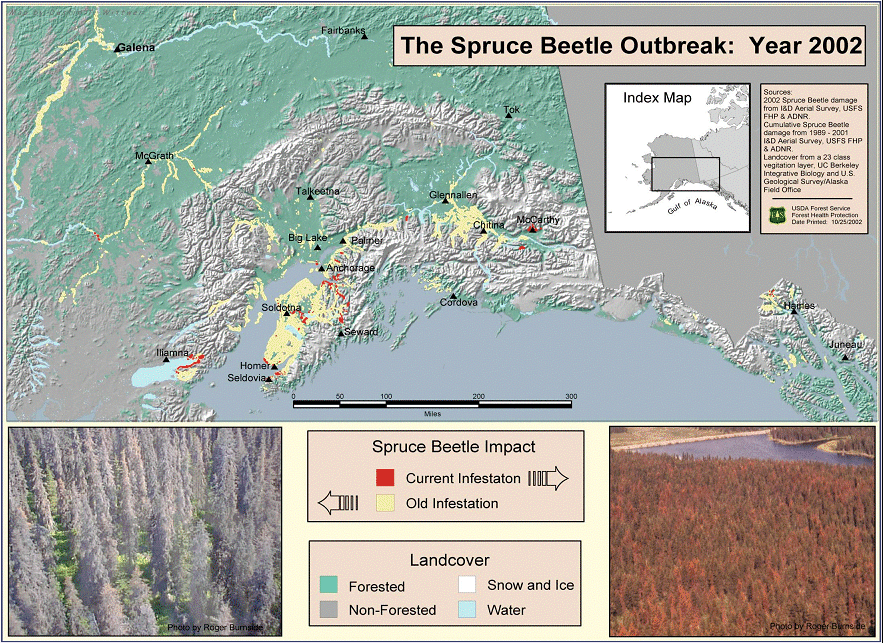Table 1. 2002 forest insect and disease activity as detected during aerial surveys in Alaska by land ownership1 and agent2. All values are in acres.
| Damage Agent |
National Forest |
Native Corp. |
Other Federal |
State & Private |
Total 2002 |
| Alder defoliation3 |
1,159 |
502 |
113 |
75 |
1,848 |
| Aspen Leaf Miner |
|
66,871 |
128,115 |
104,482 |
299,468 |
| Birch Leaf Miner |
|
310 |
159 |
29,702 |
30,171 |
| Birch leaf roller |
|
9,384 |
6,060 |
37,380 |
52,824 |
| Black-headed budworm |
2,494 |
334 |
2 |
524 |
3,354 |
| Cedar decline mortality4 |
2,835 |
39 |
8 |
150 |
3,033 |
| Cottonwood defoliation5 |
3,842 |
38 |
14,640 |
1,337 |
19,857 |
| Hemlock canker |
230 |
|
|
9 |
239 |
| Hemlock sawfly |
743 |
|
|
612 |
1,355 |
| Ips engraver beetle |
32 |
379 |
601 |
241 |
1,253 |
| Larch beetle |
|
|
4,849 |
|
4,849 |
| Large aspen tortrix |
|
|
2,197 |
283 |
2,480 |
| Spruce aphid |
1,640 |
127 |
32 |
537 |
2,336 |
| Spruce beetle |
2,133 |
23,692 |
13,406 |
13,157 |
52,388 |
| Spruce budworm |
|
943 |
|
4,239 |
5,182 |
| Spruce Needle Cast |
|
1,277 |
2,236 |
|
3,512 |
| Sub Alpine Fir Beetle |
8 |
|
|
204 |
212 |
| Willow defoliation3 |
|
|
62 |
203 |
265 |
| Total Acres |
15,116 |
103,895 |
172,480 |
193,135 |
484,627 |
1 Ownership derived from 2002 version of Land Status GIS coverage, State of Alaska, DNR/Land records Information Section. State & private lands include: state patented, tentatively approved or other state acquired lands, patented disposed federal lands, municipal or other private parcels.
2 Table entries do not include many of the most destructive diseases (e.g., wood decays and dwarf mistletoe) because they are not detectable in aerial surveys.
3 Significant contributors include leaf miners and leaf rollers for the respective host.
4 Acres represent only spots where current mortality was noticed. Cumulative cedar decline acres can be seen in Table 2.
5 Significant contributors include cottonwood leaf beetle and leaf rollers.
Table 2. Affected area (in thousands of acres) for each host group and damage type over the prior five years and a 10-year cumulative sum.
| |
Prior Five Years (thousand acres) |
Ten Year Cumulative2 |
| Host Group / Damage Type1 |
1997 |
1998 |
1999 |
2000 |
2001 |
2002 |
| Alder Defoliation |
0.0 |
0.8 |
1.8 |
5.6 |
1.2 |
1.8 |
11.2 |
| Aspen Defoliation |
5.1 |
21.9 |
13.4 |
12.6 |
9.4 |
301.9 |
522.1 |
| Birch Defoliation |
271.9 |
0.7 |
2.8 |
2.8 |
3.2 |
83.0 |
375.2 |
| Cottonwood Defoliation |
3.0 |
6.6 |
5.6 |
5.4 |
9.9 |
19.9 |
61.2 |
| Hemlock Defoliation |
6.6 |
3.9 |
0.1 |
5.2 |
1.3 |
1.4 |
35.4 |
| Hemlock Mortality |
0.0 |
0.0 |
0.0 |
0.0 |
0.1 |
0.2 |
0.6 |
| Larch Defoliation |
267.9 |
461.8 |
159.5 |
64.9 |
17.8 |
0.0 |
1,556.6 |
| Larch Mortality |
0.0 |
0.0 |
18.4 |
0.0 |
0.0 |
4.8 |
23.5 |
| Spruce Defoliation |
49.7 |
136.0 |
5.1 |
84.7 |
61.1 |
11.0 |
814.9 |
| Spruce Mortality |
569.4 |
331.0 |
258.0 |
120.9 |
104.2 |
53.6 |
2,630.3 |
| Spruce/Hemlock Defoliation |
30.8 |
0.0 |
0.1 |
0.0 |
50.7 |
3.4 |
460.2 |
| Spruce/Larch Defoliation |
0.3 |
0.0 |
0.0 |
0.0 |
0.0 |
0.0 |
16.8 |
| Sub Alpine Fir Mortality |
0.0 |
0.0 |
0.0 |
0.0 |
0.1 |
0.2 |
0.3 |
| Willow Defoliation |
3.5 |
123.2 |
181.6 |
36.5 |
10.9 |
0.3 |
428.6 |
| Total thousands acres |
1,208.2 |
1,085.9 |
646.4 |
338.6 |
269.9 |
481.5 |
6,936.9 |
1 Summaries here identify damage mostly from insect agents. Foliar disease agents contribute to the spruce defoliation and hemlock mortality totals. Damage agents such as fire, wind, flooding, slides and animal cause damage are not included. Cedar mortality is summarized in Table 1.
2 The same stand can have active infestation for several years. The cumulative total is a union of all areas from 1993 through 2002.
 2002 Highlights for California, Oregon, or Washington
2002 Highlights for California, Oregon, or Washington  Forest
Health webpage
Forest
Health webpage

Insects
The largest outbreak of aspen leaf miner on record in Alaska was noted approximately 40 miles east of Fort Yukon, between the Yukon and Porcupine Rivers. 271,000 acres of activity were mapped in this area, while 20,000 acres were mapped near Big Delta, and 6,000 acres of activity between Fairbanks and Minto. In most cases, this activity was classified moderate to heavy.
The willow leaf miner infestation in the Yukon Flats area of northeastern interior Alaska has subsided to nearly undetectable levels. This infestation impacted hundreds of thousands of acres in this area over a span of more than 10 years. A considerable, though unquantified amount of willow mortality has been attributed to years of severe impact by this leaf miner.
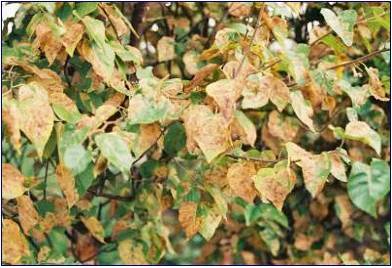
Birch leaves affected by leaf miners; photo by Forest Service.
Ambermarked birch leafminer populations once again exploded in the Anchorage Bowl. More than 30,000 acres of heavily defoliated birch were detected this year. This introduced insect has now spread north and south of Anchorage and was recently introduced into the Fairbanks area. Investigations to consider biological control opportunities of this potentially significant and newly introduced pest are underway.
Three areas of significant birch leaf roller activity were mapped this year. 30,000 acres of heavy leaf roller activity were found in the Wood River-Tikchik Lakes State Park, north of Dillingham; 15,000 acres of moderate activity near Mt. Susitna, 50 miles northwest of Anchorage and; 6,000 acres of light activity 20 miles east of Lake Minchumina. Leaf roller defoliated cottonwood on 5,287 acres along the shores of Russell Fiord and Yakutat Forelands. Another 8,849 acres of cottonwood were defoliated in Glacier Bay National Park.
Spruce beetle activity declined statewide by 50% over 2001 levels to only 52,000 acres, the lowest level in more than thirty years. This follows an epidemic, over decade long, that eliminated the majority of beetle host material (white spruce) on over 4 million acres. The activity at Lake Iliamna accounted for one-half of this total. Spruce beetle is still active in several other areas, most notably McCarthy, the Kenai Peninsula, and near White Mountain on the Seward Peninsula. Throughout the remainder of the state, with the exception of a few small, active areas, spruce beetle populations have fallen to endemic or near-endemic levels. The outbreak on the Haines State Forest continues to collapse with less than 300 acres mapped in 2002.
Spruce aphid defoliation occurred on approximately 2,300 acres in southeast Alaska from Dall Island on the south end of Alexander Archipelago to Skagway. Most of the defoliation occurred on national forest lands (1,640 acres) on the outside islands from Hecata Island south to Port Bazan, Dall Island, and along Lynn Canal to Skagway. Spruce aphid defoliation was virtually absent from the Juneau, Sitka, Ketchikan, and Wrangell boroughs.
In 2002, black-headed budworm activity was mapped on 3,400 acres, down significantly from 2001 levels of approximately 51,000 acres. Nearly all of this acreage was mapped in Prince William Sound.
Hemlock sawfly occurred on 1,400 acres, mostly south of Sumner Strait. Most hemlock sawfly defoliation occurred on the southwest end of Kosciusko Island on state (600 acres) and national forest (400 acres) lands.
 2002 Highlights for California, Oregon, or Washington
2002 Highlights for California, Oregon, or Washington  Forest
Health webpage
Forest
Health webpage

Diseases
The most important diseases and declines of Alaskan forests in 2002 were wood decay of live trees, root disease of white spruce, hemlock dwarf mistletoe, and yellow-cedar decline. Except for yellow-cedar decline, trees affected by these diseases are difficult to detect by aerial surveys. Nonetheless, all are chronic factors that significantly influence the commercial value of the timber resource and alter key ecological processes including forest structure, composition, and succession. Wildlife habitat is enhanced through the development of hollow tree cavities by heart rot fungi and witches' brooms by hemlock dwarf mistletoe and broom rust fungi.
In Southeast Alaska - approximately one-third of the gross volume of forests is defective due to stem and butt rot fungi. Hemlock dwarf mistletoe continues to cause growth loss, top-kill, and mortality in old-growth forests; its impact in managed stands depends on the abundance of large infected trees remaining on site after harvesting.
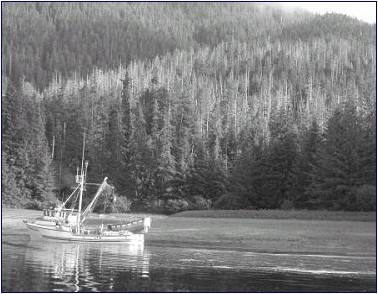
Trees affected by cedar decline; photo by Paul Hennon, Forest Service.
Nearly 500,000 acres of yellow-cedar decline have been mapped across an extensive portion of southeast Alaska. In 2002, areas of particularly current yellow-cedar mortality were observed on about 3,000 acres scattered around Southeast Alaska, with the most numerous areas being in Peril Strait, western Baranof Island and southwest Chichagof Island. Snags of yellow-cedar accumulate on affected sites and forest composition is substantially altered as yellow-cedar trees die, giving way to other tree species. The wood in dead standing trees remains valuable long after tree death and salvage opportunities for this resource are now being recognized.
Cone diseases and other foliar diseases of conifers were generally at low levels throughout Alaska in 2002. Canker fungi were at endemic levels, causing substantial, but unmeasured, damage to hardwood species in south-central and interior Alaska. Canker fungi on conifers, particularly on Sitka spruce and subalpine fir, occurred at higher than normal levels and caused branch dieback in southeast Alaska.
In south-central and interior Alaska - tomentosus root rot continues to cause growth loss and mortality of white spruce in all age classes. Various stem and butt rot fungi cause considerable defect in mature white spruce, paper birch and aspen stands. Saprophytic decay of spruce bark beetle-killed trees, primarily caused by the red belt fungus, continues to rapidly degrade dead spruce trees.
A late spring frost damaged vegetation throughout southeast Alaska in 2002. Many conifers species and evergreen broadleaf plants expressed shoot dieback as the result of warm spring temperatures followed by a cold spell in early April.
 2002 Highlights for California, Oregon, or Washington
2002 Highlights for California, Oregon, or Washington  Forest
Health webpage
Forest
Health webpage

Invasive Organisms
Arthropods - In the past several years, several introduced pests have been detected in the Anchorage area. In 2002, the ambermarked birch leafminer (newly described in 2002), uglynest caterpillar, and the European black slug were all reported in Alaska. The ambermarked birch leafminer caused heavy birch defoliation throughout Anchorage. These invasive pests and others may become established throughout Alaska if detection and eradication methods are not employed early. Primary detection of these introductions has been through the Integrated Pest Management Program sponsored by the USDA Forest Service and administered by the Alaska Cooperative Extension Service.
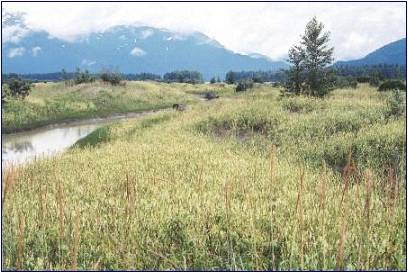
White sweetclover (Melilotus alba) growing along the Stikine River; photo by Michael Shephard, Forest Service.
Plants - Several species continue to spread into different areas of the state. White sweetclover, Melilotus alba, occupies hundreds of acres along the Stikine River in southeastern Alaska, and is now showing up on the Nanana River in the interior. Bird vetch, Vicia cracca, is widely distributed in southern Anchorage, the Matanuska Valley, and in portions of Fairbanks. A new species of noxious weed for Alaska is garlic mustard, Alliaria petiolata, which was first found in Alaska in 2001. This new infestation is located just below the Governor's mansion in Juneau. Thousands of plants were collected at this sole known infection site to prevent seed
set in 2002.
Several other species are being mapped across the State. Agency inventories are being coordinated for consistency and entered into a state-wide GIS inventory base. As a result of these coordination efforts, cooperative control projects are planned to address these relatively newly recognized threats to Alaska forest resources.
 2002 Highlights for California, Oregon, or Washington
2002 Highlights for California, Oregon, or Washington  Forest
Health webpage
Forest
Health webpage

Contacts and Additional Information
If you have questions about forest health in Alaska,
please contact:
State of Alaska
Roger Burnside
Alaska Department of Natural Resources
550 W. 7th Avenue, Suite 1450
Anchorage, AK 99501-3566
(907) 269-8460
rogerb@dnr.state.ak.us
Forest Service
Jerry Boughton
(907) 743-9461, jboughton@fs.fed.us
Michael Shephard
(907) 743-9454, mshephard@fs.fed.us
USDA Forest Service
Alaska Region
3301 'C' Street, Suite 202
Anchorage, AK 99503
go to a more printable PDF version of this
document
 2002 Highlights for California, Oregon, or Washington
2002 Highlights for California, Oregon, or Washington  Forest
Health webpage
Forest
Health webpage
This webpage was last updated on August 9, 2005; reformatted May 2008.
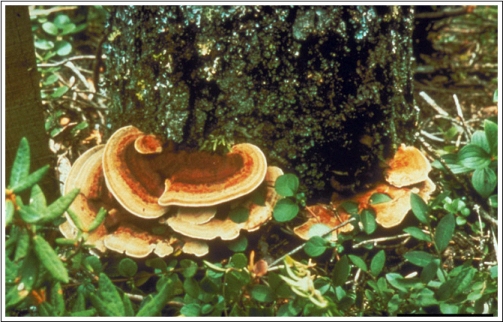
![]() 2002 Highlights for California, Oregon, or Washington
2002 Highlights for California, Oregon, or Washington ![]() Forest
Health webpage
Forest
Health webpage

![]() 2002 Highlights for California, Oregon, or Washington
2002 Highlights for California, Oregon, or Washington ![]() Forest
Health webpage
Forest
Health webpage


